
20 minute read
THE LONGEST MONTH FROM THE AIRFIELDS TO THE SEA
BY DAVID STEELE
The capture of Mount Suribachi is the ultimate symbol of triumph in military history. However, it was only the beginning of the most grueling month of battle an American fighting force would ever know.
Joe Rosenthal’s photo of the flag-rais- ing on Mt. Suribachi is so well known that some general references imply – or even say – the event marked the end of the battle for Iwo Jima.
If only it were so. There was certainly nothing easy about Suribachi, but the battle for the rest of the island was even more vi- olent and considerably longer. One statistic underscores the point: A total of 27 Medals of Honor were awarded for heroism on Iwo; all but three were earned up-island, beyond Mt. Suribachi. In addition, nearly one-third of all Marines killed during World War II lost their lives either during the Battle of Iwo Jima or from injuries sustained on the tiny island of lava and sulfur.

The 24th Marines prepare to attack Motoyama Airfield No. 1 Feb. 20, 1945, at H-hour, 0900, 500 yards inland from Yellow 2 Beach.
U.S. MARINE CORPS HISTORICAL CENTER
Even hard-bitten veterans, not given to rose-colored assessments, underes- timated how deeply and widely the Japa- nese were dug in and how cunningly they would use their advantages. After Mt. Su- ribachi’s fall, V Amphibious Corps (VAC) Commander Maj. Gen. Harry Schmidt re- peated his timing forecast for the entire campaign. “I said last week it would take 10 days, and I haven’t changed my mind,” said the general.
He wasn’t even half right.
Lt. Gen. Tadamichi Kuribayashi, a Japa- nese tactical genius with the fortitude and patience befitting his samurai ancestry, had arrayed two broad, convex zones of resistance from coast to coast with their centers jutting toward Suribachi. The first overlapped much of Airfield No. 2 and looked down on a natural east coast boat basin. The second began just behind Air- field No. 2, included the incomplete third airfield, and boasted some of the island’s most rugged terrain.

advertisement
These zones would become the tough- est nuts to crack. In reality, the island’s defenses were so abundant, so varied, and so insidious that it was impossible to find a weak point.
Compounding that was the philosophy of the Japanese defenders, and their for- midable commanding general, who was re- knowned as a one-man fighting force with boundless courage. Kuribayashi circulated what were called “The Courageous Battle Vows,” copies of which were found in pill- boxes, caves, bunkers, and on the bodies of dead Japanese soldiers. They stated:
“Above all, we shall dedicate ourselves and our entire strength to the defense of this island.
“We shall grasp bombs, charge enemy tanks and destroy them.
“We shall infiltrate into the midst of the enemy and annihilate them.”
Because of the Japanese convex defense and these vows of non-surrender, it was difficult, especially in the early days, to apply traditional terminology to the battlefield. There were definable front lines that could more or less be plotted on a map. There was a rear that couldn’t be found among the mortar attacks, mines, bypassed pillboxes, spider traps, and nightly infiltrators.
It’s no wonder that many of those who were on Iwo would later say that, in essence, all of Iwo was a vicious front. You could die from any direction.
As the Marines of the 4th and 5th Marine Divisions began the arduous drive to the sea on the north, it was hoped that the 3rd Division could remain in seagoing reserve. By the end of just the second day, however, the 5th Division had lost 1,500 men killed or wounded and the 4th lost about 2,000.
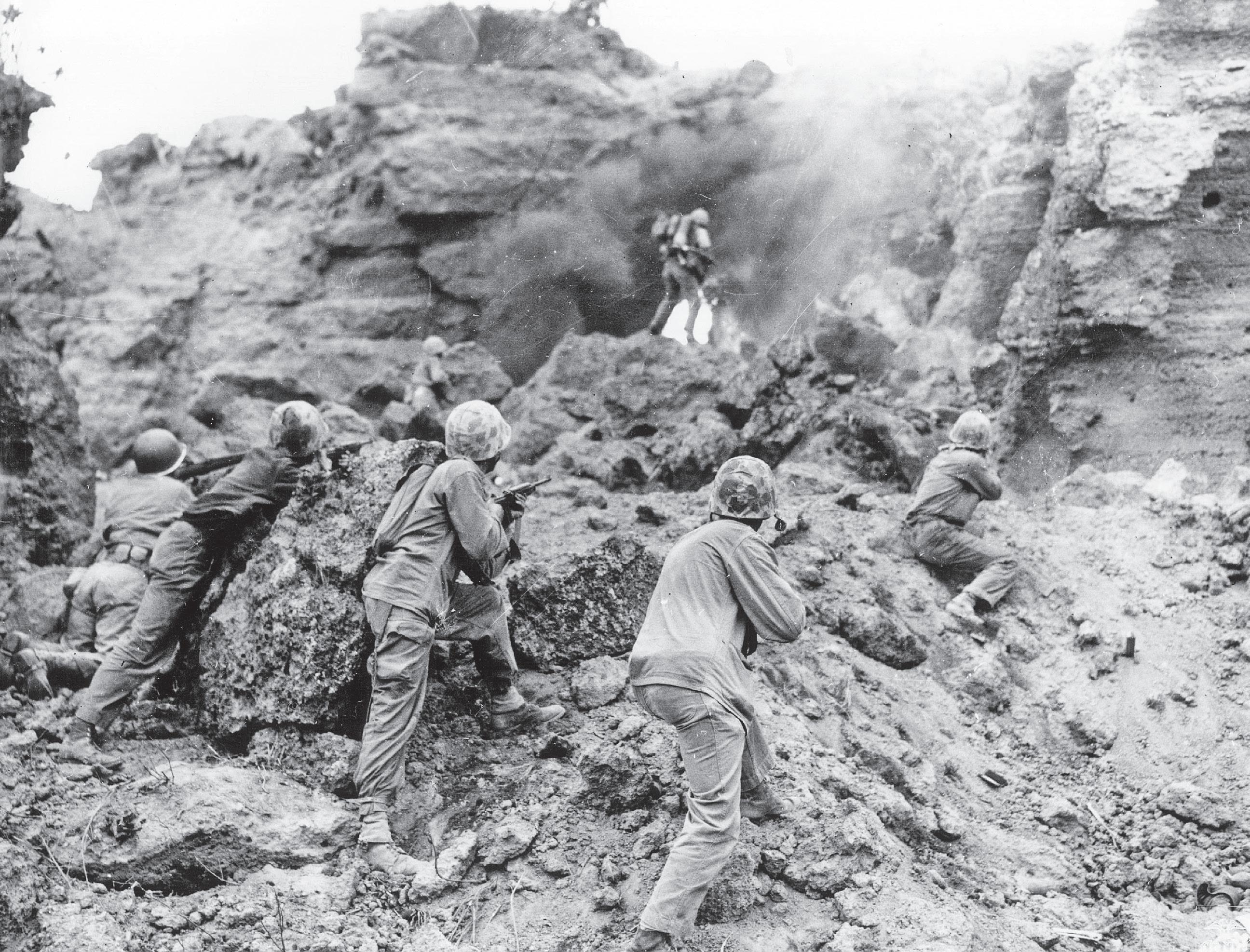
Covered by Marine riflemen in the foreground, a Marine flamethrower clears an enemy cave on the north side of the island. Persuasion was attempted first, but as was the case with most of the Japanese soldiers, surrender was not an option.
U.S. MARINE CORPS HISTORICAL CENTER
“I know that just our 40-man platoon had 36 people either killed or wounded at Iwo Jima,” Cpl. Charles Lindberg said. “And we were among the most seasoned fighters; most of us had either been to Guadalcanal, Bougainville, or both.”
Clearly the luxury of holding back the 3rd couldn’t be enjoyed. Its 21st Regiment landed and was initially attached to the 4th Division, passing through the 23rd Marines on D+3 (Feb. 22). Two days later, the division’s 9th Regimental Combat Team joined the fray following the landing of the division HQ the previous day.
Throughout the campaign, various regiments of each division would frequently be shared or operate in coordinated commands. Basically, the 3rd Marine Division took the center of the line with the 5th Marine Division on the left flank and the 4th Marine Division on the right. Each assignment came with formidable ground to take and thousands of Japanese defenders determined not to surrender it.
“My opinion is that we were fighting the very best fighters that Japan had,” Lindberg said. “Boy, were they tough – and not afraid to die, either.”
Yet not all of the advantages went to the Japanese. The Marines had considerable fire support from the sea and air. In fact, Kuribayashi was convinced he could hold out indefinitely if there were no aerial and ship bombardment.
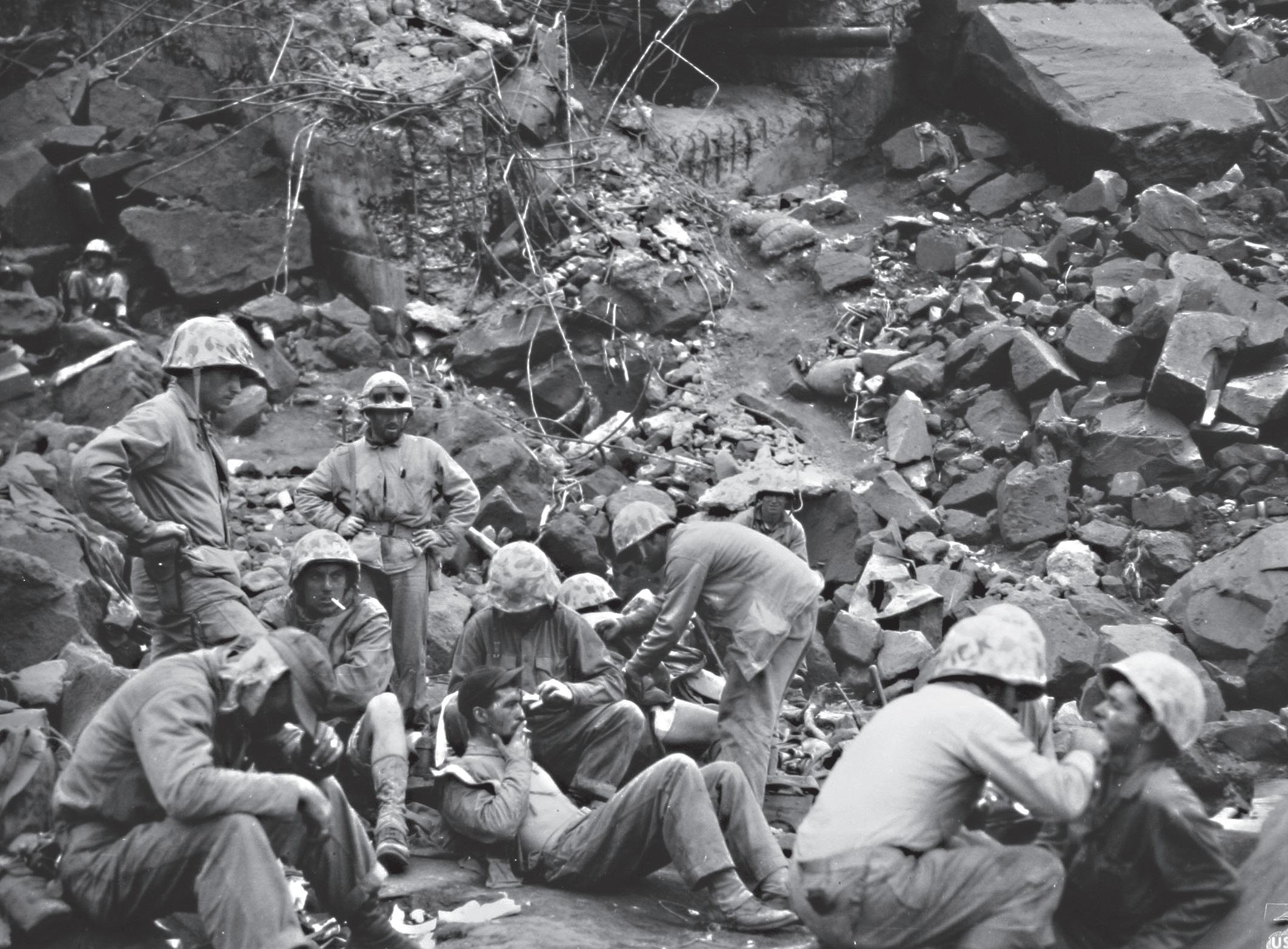
Sheltering in the rubble of a Japanese fortification, Marine casualties are given medical attention on Feb. 26, 1945, at an aid station in the cliffs near the East Boat Basin on Iwo Jima.
U.S. MARINE CORPS HISTORICAL CENTER
“The Japanese defense on Iwo Jima was perhaps the most consistent and effective of any in the Pacific war. It was carefully planned to make the maximum use of the terrain and the plan was faithfully followed to the end,” Marine Capt. Clifford P. Morehouse, USMC Reserve, wrote in a 1946 Marine Corps paper, “The Iwo Jima Operation.”
Consequently, the Japanese high command made one concerted effort to send help in the form of kamikazes – suicide pilots who would turn their planes into dive bombs and point them at the decks of Allied ships. The newly created tactic would later be especially effective at Okinawa. It took its toll at Iwo, too, when on Feb. 21, kamikazes sank the escort carrier Bismarck Sea and sent a major carrier, the badly damaged USS Saratoga, limping back to Pearl Harbor for repairs.
A sizable U.S. armada of nearly 800 vessels remained on station, however, and as the work of taking Iwo began, each day’s assault began with air-sea bombardments. They were soon joined by land-based Marine artillery that came ashore in increasing numbers, as the Seabees, usually under fire, cleared and matted the beaches and carved roadways into the core of Iwo Jima.
Determined fighting had put Motoyama Airfield No. 1, a primary objective, into Marine hands by the end of D+l. Furthermore, the 4th and 5th Divisions had combined to carve a line across the island, cutting off Mt. Suribachi from the rest of Iwo Jima.
The drive to Airfield No. 2 began. The ground was particularly treacherous there, because the Japanese had sighted their guns down the runways and flat expanse, had their artillery and mortars pre-registered for the assault, and, as always, had a multitude of machine gun nests and riflemen hidden in strategic positions. What’s more, the heights to the north made the entire sector around the airfield a “no man’s land” that was defended by elite Japanese troops.
The entire gruesome network of defense erupted as the 23rd Marines of the 4th Marine Division began its attack on D+4.
“The 23rd is being held up by minefields on both flanks. Fields are covered by heavy artillery and small arms fire,” a communications man with the 23rd Marines radioed to offshore command. “The entire regimental front is receiving mortar fire. Maximum use is being made of supporting weapons.”
All of these factors stalled the move up Iwo’s center, as each new attempt brought heavy casualties. But there was no way around, so the Marines had to go up, over, and through the terrain and its defenders.
As with most battlegrounds, a few landmarks on Iwo would soon take on descriptive names. Most of the hills, though, were known simply by numbers that denoted their height in feet. In 3rd Division history, one of the most famous is Hill 199, at the northern edge of Airfield No. 2. In a pattern repeated countless times, the defenders hadn’t just fortified the hill’s face: They’d entrenched pillboxes and fighting positions on the reverse slope as well, making the fighting along the top and opposite side as horrific as the ascending assault.
Led by 1st Lt. Raoul Archambault, K Company of the 3rd Battalion of the 21st Marines finally gained a tenuous foothold on Hill 199 on its third try. The 3rd Marine Division history, written by 1st Lts. Robert A. Aurthur and Kenneth Cohlmia, describes what happened next:
“... suddenly a wave of [Japanese] infantry rose out of the gully on the reverse slope of the hill and counterattacked with bayonets. That fight, in the ankle-deep sand which clutched at men, tripped them and clogged their weapons, will be recalled as one of the most freakish nightmares of the Iwo battles ... K Company battled with bayonets, knives, clubbed rifles and entrenching shovels in a savage, hacking, screaming melee that was over in a few minutes with nearly 50 Japanese killed in hand-to-hand combat.”
This time the bloodied, battle-weary Marines held the hill.
Less vivid, but no less intense, were the smaller fire team battles for a seemingly never-ending succession of pillboxes and caves. Each presented its own unique challenges, because they were typically interlocked and defended with mutually supporting fire.
A typical scenario called for a team to lay down a covering fire and hold the defenders’ attention while a Marine with a flamethrower or satchel charge tried to move in and around the stronghold’s flank. If that tactic was successful, a pillbox might be silenced.
However, it still posed a multitude of threats. Its occupants might be alive inside, waiting to ambush the Marines as they drew close. They might also be hiding in another area of the bunker’s labyrinth. Or they might have escaped to an entirely new position to start the process again. Also, if the Marines weren’t careful, the defenders would abandon the position for the moment, then return later to re-man it under cover of darkness.
“When we moved into the pillboxes, we didn’t know the situation,” Lindberg said. “I’d fire my flamethrower in the entrance, but they might come out the sides, out the back, or someone might get me from behind. You just didn’t know.”
The initial attack team did its best to close off the stronghold with the limited time and resources it had. Then it was left to the engineers to follow up, preferably sooner than later, to seal the bunker or cave with explosives and prevent further use.
The complexity of many of these underground mini-fortresses was remarkable.

A Marine flamethrower team silences an enemy dugout on Iwo Jima. While two riflemen cover the entrance, the flamethrower showers the position with liquid flame.
U.S. MARINE CORPS HISTORICAL CENTER
They might feature six, eight, or even a dozen separate entrances, connected to just as many corridors, tunnels, and rooms surrounded by concrete up to 10 feet thick. Many pillboxes barely peeked above the ground, and unwary Marines literally didn’t know until it was too late that there was anything or anyone there. Snipers popped in and out of spider holes (holes camouflaged with flat, removable covers) just as Marines approached or went past.
If the infantry was fortunate, the terrain would allow for support by tanks, both traditionally armed Shermans and flamethrowers that were ideal for taking out pillboxes. But the tanks were also a mixed blessing for both their crews and the “ground-pounders,” because nothing drew the attention of defenders like a tank rolling forward into battle.
Mortars and rockets would inevitably cascade down on them, creating a ring of havoc for anyone caught nearby. Moreover, the maneuverability that tanks enjoyed on other battlefields wasn’t possible on Iwo. They often had to advance one by one or in single-file right into the jaws of strategically placed anti-tank weapons or mines.
“As the battle progressed, the enemy planted more and more mines, and the cooperation of the infantry’s attached engineers to clear routes for us was continually sought,” Maj. John Frothingham wrote in the July 1945 issue of Leatherneck. “Tank people had tried to be in the fight with the infantry, but it became increasingly annoying when our tanks were destroyed by mines behind the front lines.”

Members of a Marine Corps war dog platoon move up to the front lines on Iwo Jima. The dogs were a great asset due to their ability to ferret out enemy snipers and to act as speedy messengers.
U.S. MARINE CORPS HISTORICAL CENTER
On one assault, a Sgt. McIntire of Charlie Company got his tank stuck on the rocks forward of the northern lines. Japanese soldiers immediately swarmed the tank despite protective fire from other tanks. Lt. Dusty Blake, in another tank, radioed to McIntire, “Don’t be afraid, Mac – open your hatch and drop a grenade on them!”
“But I am afraid, Mr. Blake.”
Despite the likelihood in his mind that he would be gunned down, McIntire mustered up the courage to open the hatch. He dropped several grenades, then radioed back to Blake, “He shouldn’t bother us now. I blew the SOB’s head off.”
All of these factors continually put the Marines behind the timetables originally set for taking Iwo. Much more importantly, the fighting took a terrible toll: After six full days of battle, 1,605 Marines were dead and 5,496 wounded. Kuribayashi still controlled twothirds of Iwo Jima.
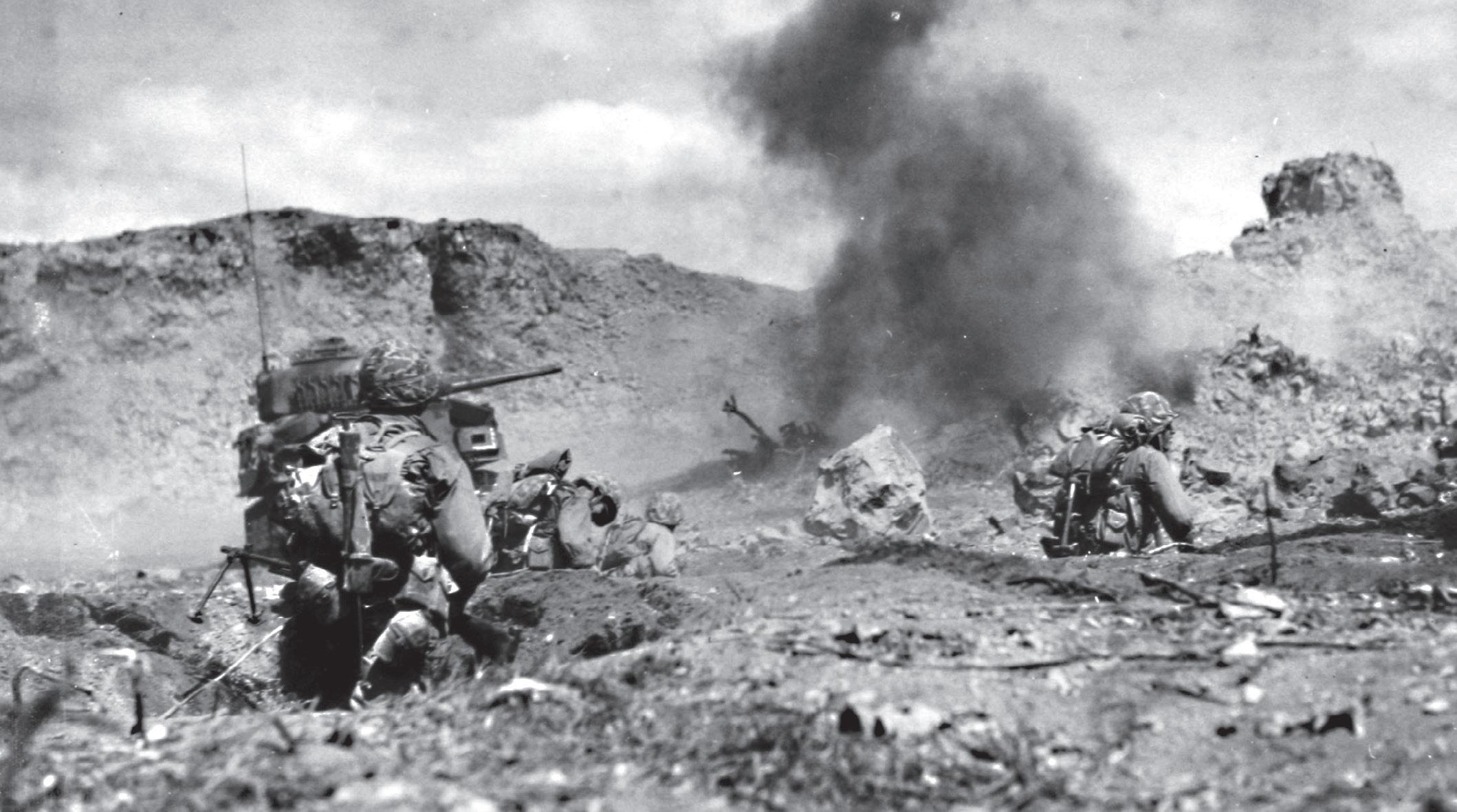
Marine infantry and tanks attack Japanese positions on rocky northern Iwo Jima during a direct frontal assault. The explosion seen is an enemy mortar shell. This advance gained 20 yards at a cost of 30 Marine casualties.
U.S. MARINE CORPS HISTORICAL CENTER
The 4th Marine Division had already encountered and overcome such challenging obstacles as Charlie-Dog Ridge as it pushed up Iwo’s eastern coast. The toughest test was yet to come in the form of the Hill, the Amphitheater, and Turkey Knob; these points became known collectively as the Meat Grinder.
Perhaps no battlepoint has been more aptly named. The Meat Grinder contained a major communications center that the Japanese defended tenaciously with anti-aircraft guns, artillery pieces, anti-tank guns protected in caves, and the familiar strongholds with interlocking fire of all types. A new wrinkle came in the form of tanks buried to their turrets.
The three areas were mutually supported so well that it required a coordinated, simultaneous attack on all three sites at once. Such cooperative movement is challenging in any circumstance; in the confines of Iwo Jima and its extreme conditions, it was nearly impossible.
Nevertheless, the 23rd Marines tackled the Hill, the 24th Marines took on the Amphitheater, and the 25th Marines assaulted Turkey Knob. Time after time, an immediate objective would be taken, then the assault would come under renewed fire from positions to the front, sides, and rear. Mangled companies and platoons would be forced to withdraw, and the defenders would move back in.
The reason why repeated naval gunfire and aerial bombardment were important but never decisive was now becoming apparent. The durability of many major fortifications was simply beyond belief, and another reminder of how vital Japan considered this tiny island to its survival. At one point around Turkey Knob, the Marines brought in a 75 mm howitzer and fired it again and again point-blank into an emplacement. After 85 rounds, the fortification still hadn’t succumbed.
On one day alone, Turkey Knob and the Amphitheater cost the 4th Division 792 casualties. That was even worse than the first two days on the beaches. It took a full seven days – from Feb. 26 to March 3 – for the Marines to conquer the Meat Grinder. By that point, the division had lost 7,591 men to death or injury since landing on Iwo, and its fighting capacity was down by 30 percent.
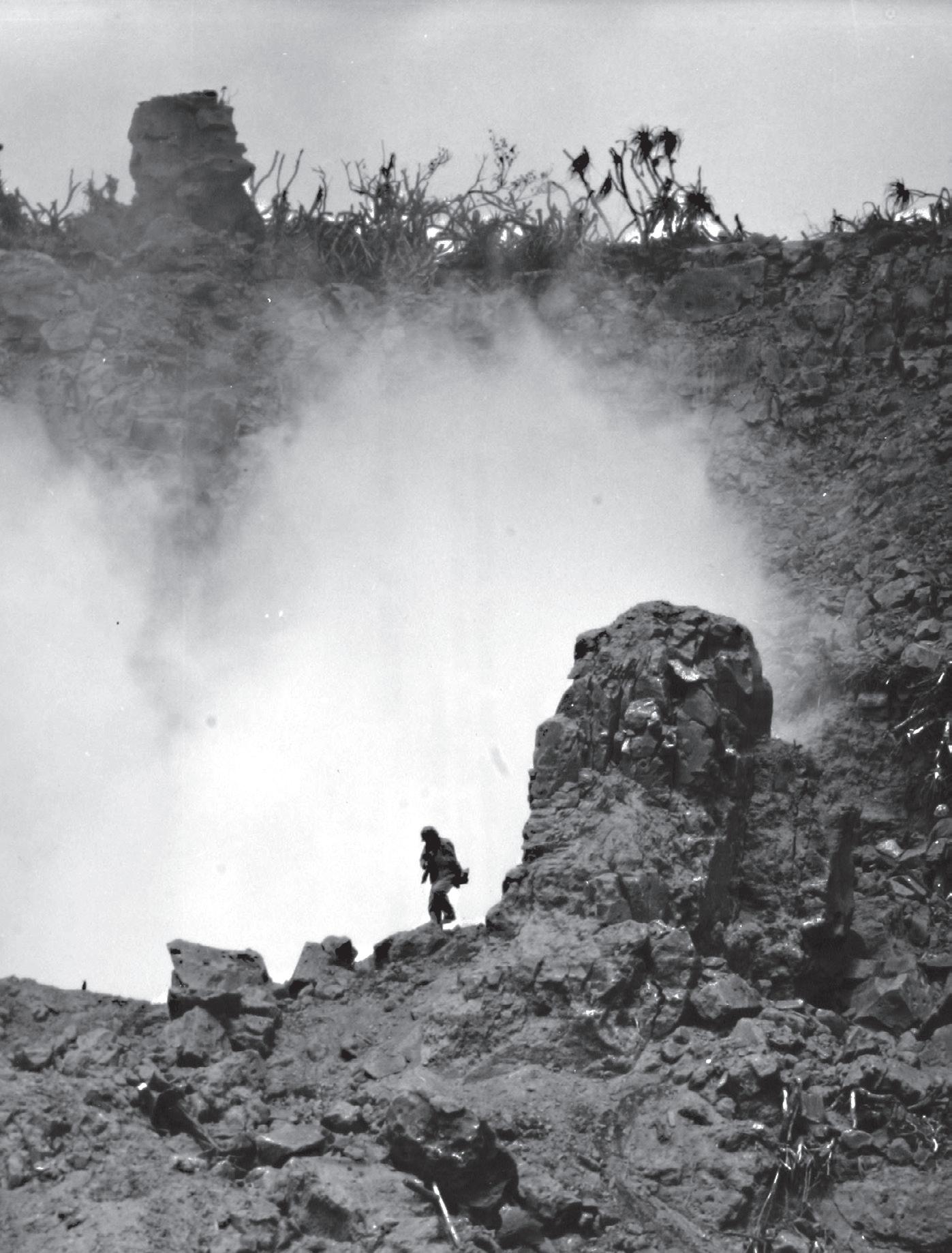
In a deep ravine on the northern ridges of Iwo Jima, Marines use high explosives to destroy Japanese caves and pillboxes. The terrain at the northern end of the island was rocky, volcanic, and stank of sulfur.
U.S. MARINE CORPS HISTORICAL CENTER
Diminished fighting capacity began to plague virtually every unit, although replacement troops for the casualties were moved in as quickly as possible. Certainly the fresh Marines didn’t lack stamina, spirit, or courage, but often they didn’t have the previous battle experience of the initial frontline troops.
As a result, many became casualties themselves almost as soon as they reached the battleground. Rank had few privileges on Iwo Jima. Officers and noncommissioned officers were always prime targets. When the enemy enjoyed the advantage of position as did the Japanese, the situation was made worse as gunners took their time to carefully spot command posts, communications centers, and troop leaders.
Nineteen of the 24 original battalion commanders who landed on Iwo became casualties. Among them was the leader of the 3rd Battalion, 24th Regiment, Lt. Col. Alexander A. Vandegrift Jr., son of the commandant of the Marine Corps. Although he survived a mortar hit to his command post, he was wounded in both legs.
Less fortunate was Lt. Col. Chandler Johnson, the man who led the battalion that planted the flag on Mt. Suribachi. After his 28th Regiment left the mountain to help the drive up the island’s west coast, Chandler took a direct hit from a mortar shell. The heroes of the flag-raising on Mt. Suribachi, Company E of the 28th Marines, 5th Marine Division, were reduced to a very few survivors when they came in with Johnson to help take Hill 362A.
Despite the carnage, the attack pressed on. On March 4, the Marines got a huge reminder of exactly why Iwo Jima was strategically important as the first jumbo B-29 Superfortress made an emergency landing there. The airfield immediately came under mortar attack, so repairs were completed quickly and the bomber was sent on its way.
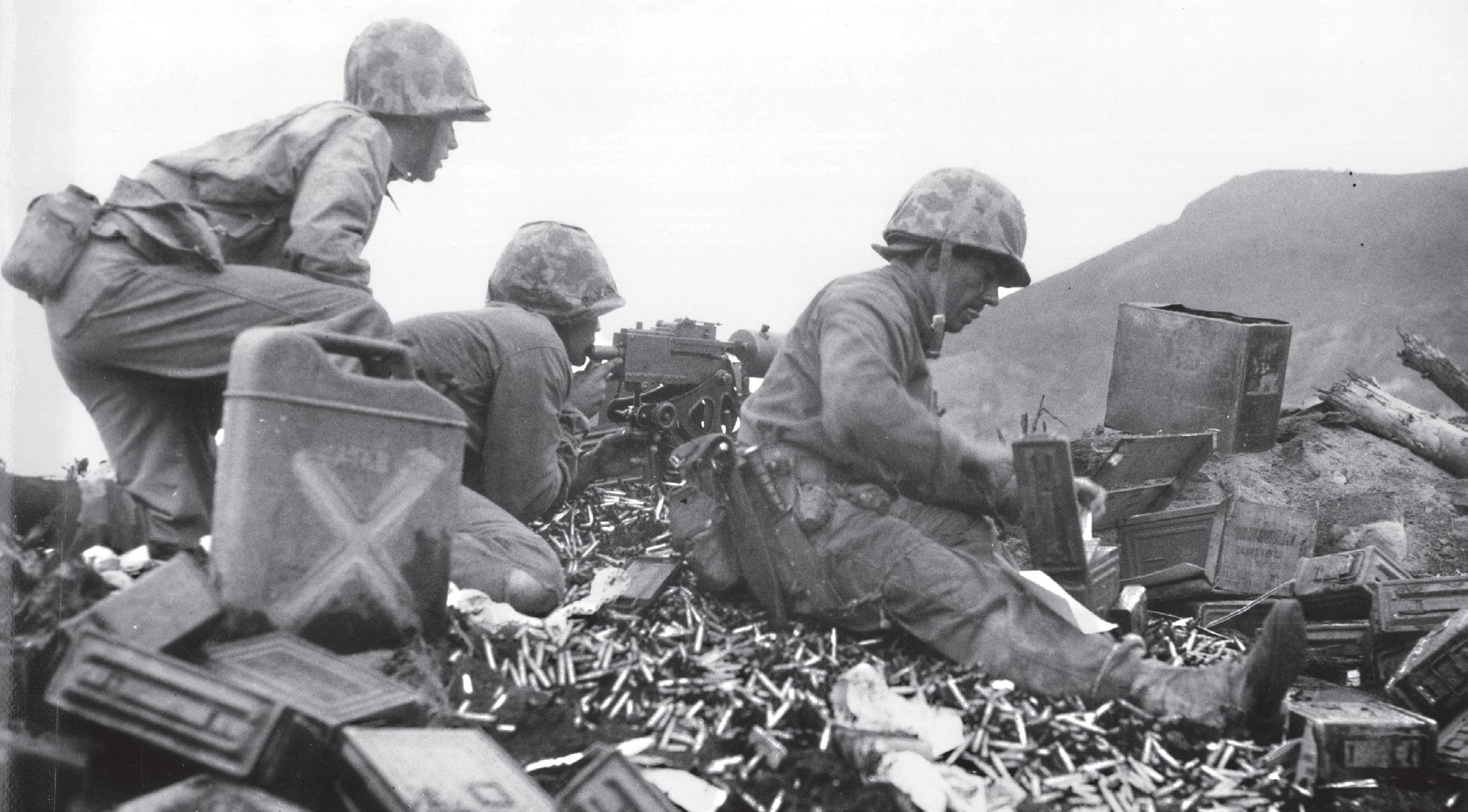
Marines manning a .30-caliber machine gun crouch amid a welter of spent shell casings and empty ammunition boxes. While a common misconception holds that the capture of Mt. Suribachi marked the end of the fighting at Iwo Jima, the truth is that the battle had just begun. The fighting during the month that followed was among the most grueling in the history of America’s armed forces.
U.S. MARINE CORPS HISTORICAL CENTER
The event was a major morale booster for troops who were now measuring daily gains in feet rather than yards. One of the legendary obstacles was a place called Cushman’s Pocket. Named for Lt. Col. Robert E. Cushman Jr., who headed the 2nd Battalion of the 9th Marines, the pocket became the 3rd Division’s equivalent to the Meat Grinder. It was one of the most perfectly devised fortifications on the island, recalls the division’s history.
The Japanese even had a surprise or two left. At one point, the Marines were moving against what seemed to be huge mounds of earth. Suddenly the ground roared to life as five Japanese tanks rumbled out of covered emplacements and opened fire. Dripping rocks, shrubs, and earth, they were about to crush the 1st Battalion’s flank when Company I Commander Capt. Edward V. Stephenson rallied flamethrowers and bazooka men in a counterattack. The charge destroyed three tanks, while air support took out the other two.
The defenders held on to the pocket’s core using every resource they had, especially against Marine tanks. They’d first scatter the infantry with an air burst, then charge the tanks under cover of smoke, armed with satchel charges and Molotov cocktails.
The Japanese also counterattacked in force. In one pre-dawn raid, more than 200 Japanese soldiers tried to squeeze between the lines of two battalions. An hourlong battle ending with hand-to-hand combat ensued.
The next morning the Marines found 161 dead Japanese soldiers around their lines.

The Japanese soldiers’ philosophy of non-surrender made capturing them alive something of a rarity on Iwo Jima. The “Courageous Battle Vows” of the island’s defenders read as follows: “Above all, we shall dedicate ourselves and our entire strength to the defense of this island. We shall grasp bombs, charge enemy tanks and destroy them. We shall infiltrate into the midst of the enemy and annihilate them.”
U.S. MARINE CORPS HISTORICAL CENTER
As it became clear, the pocket couldn’t be taken by frontal assault, the objective became Hill 362A to its rear. The Marines launched their own surprise. Daylight assaults, preceded and supported by air-sealand bombardment, were the rule of thumb on Iwo. The one exception came on March 7.
The plan was for the 21st Marines to seize Hill 362A in a daring pre-dawn attack, while the 9th Regiment made a diversionary movement. There was no initial bombardment, and the surprise was complete. At dawn, the two regiments came under intense fire. It appeared the objective was taken, but a combination of two similar landmarks and incorrect maps put the Marines on Hill 331, not 362A.
More determined fighting, and the essential support of tanks, eventually put the 9th Regiment’s 3rd Battalion on the right hill. Moreover, during the night, troops had covered a substantial amount of heavily fortified ground that no longer required frontal assault.
Best of all, the Marines now held the commanding terrain in the north. And the novelty of being able to look down on the enemy rather than being under his continual observation, notes the division’s historians, “was by far the greatest boost to morale the 3rd Division had experienced.”
As the Marines advanced, the Japanese became more desperate. For example, the 5th Division surrounded and took one hill relatively easily. Then, as Marines raced to the peak, the top literally blew off as the defenders destroyed their own command post, causing 43 Marine casualties.
On March 8, the Japanese conducted the banzai attack the Marines had been expecting since the first night. The date was not coincidental. Japan commemorated the eighth of every month since it marked the date (on their calendar) for their attack on Pearl Harbor.
This night, nearly 1,000 men, some armed only with bamboo spears, crept close to the 4th Division lines. A few ingenious defenders dragged stretchers behind them as though they were transporting wounded, and yelled, “Corpsman!” in English to try to deceive American troops. The bulk of the Japanese rose up and charged, screaming “Banzai!” and directed their efforts at the point where the 23rd and 24th regimental zones joined. The Marines were ready, but still had 90 men killed and 257 wounded. It was much worse for the Japanese: 784 bodies were found.
Finally, after 18 days of the toughest fighting the Marines had ever experienced, a patrol from A Company, 1st Battalion, 26th Marines, reached Iwo’s northern end on March 9. They relayed a canteen with saltwater back to Maj. Gen. Schmidt with the now-classic message, “For inspection, not consumption.”
On March 16, the island was officially declared secure, a term that drew derision and anger from many of those still fighting a determined enemy. By no means was the battle over, even as the Army began to garrison the island.
Kuribayashi was still defending the island from his stronghold, an impenetrable bunker 60 feet under the north end of the island. On March 21, the general signaled the nearby island of Chichi Jima: “We have not eaten or drunk for five days. But our fighting spirit is still running high. We are going to fight bravely to the last ... The enemy front line is 200 or 300 meters from us and they are attacking by tank firing.
“They advised us to surrender by loudspeakers, but we only laughed at this childish trick and did not set ourselves against them.”
On March 24, Kuribayashi sent out his final signal: “All officers and men of Chichi Jima – good-bye.” His body was never found; some suspect that he was severely wounded in the final Japanese offensive of the battle, and committed suicide rather than surrender. No one is certain.
The mop-up operation was conducted swiftly. The 3rd Division concentrated on still heavily fortified resistance near Hill 362C. When that was completed on March 16, they joined the 5th Division to compress Japanese troops into the area around Kitano Point, at the northern tip of Iwo Jima. On March 25, the 28th Marines – including just four of the 40 men from the Company E platoon that had planted the first flag on Suribachi – walked into a gorge that was honeycombed with caves. More than 500 Japanese were there, and they fought to the end. The location was later known as “Bloody Gorge” and “Death Valley.” The 4th Division worked on last pockets of resistance between the East Boat Basin and Tachiiwa Point, along the central east coast immediately east of the Meat Grinder.

At the March 21, 1945 dedication of the 5th Marine Division cemetery on Iwo Jima, the cemetery flag is raised. The 5th Division had lost 1,500 men killed or wounded by the end of just the second day of fighting on the island.
U.S. MARINE CORPS HISTORICAL CENTER
On March 26, hundreds of Japanese made a final major attack. They hit the Army’s 506th Anti-aircraft Battalion just above Airfield No. 2, quickly over-running positions and attacking Marines and soldiers as they slept in their tents. Only a concerted effort by infantry, pilots, truck drivers, and medics quelled an attack that claimed more than 50 American and 262 Japanese lives.
At long last, the mission was truly accomplished.
It cost 6,821 American lives (including 5,931 Marines) to conquer Iwo Jima, plus more than 2,000 others who later died of their injuries in American veterans’ hospitals. In all, there were 25,851 U.S. casualties.
Kuribayashi and his 21,000 men hadn’t killed 10 Marines for every Japanese, as they vowed. But they had died trying as they made Iwo Jima the most costly action the Marines had ever endured. Few Japanese surrendered.
Yet any mention of the valiant men lost must also acknowledge the valiant men spared. After that first B-29 landing on March 4, there were 852 similar forced landings over the next three months. The Army Air Force estimated that more than 9,000 pilots and crew members were saved because the Marines, with the support of the Navy, took Iwo Jima at all costs.










